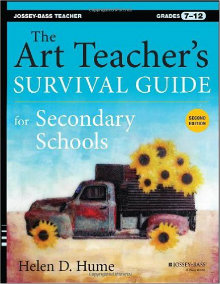A Smart Guide to Art Lessons and Projects
The Art Teacher’s Survival Guide for Secondary Schools, 2nd Edition
By Helen D. Hume
(Jossey-Bass, 2014 – Learn more)

Most would agree, either through personal experience or observation, that not enough students have access to art education. The Art Teacher’s Survival Guide for Secondary Schools claims to be the answer for both “seasoned and inexperienced” teachers of art students in grades seven through twelve.

Helen D. Hume aims for artists, homeschoolers, art coordinators, and even teachers of other subjects to find this book useful. The purpose of art instruction, she says, “…is to teach students to see and interpret.”
Survival Strategies
Chapter 1 discusses some basic survival strategies for any classroom and for the art classroom in particular. Suggestions include getting to know students and taking an interest in them, being fair, mentoring, keeping a table near the door with art supplies to motivate students, having a seating chart, developing a studio environment, and giving open-ended assignments.
The author suggests the first project should be non-threatening. There are materials and safety suggestions, as well. She also wants to make the whole school look (visually) good and for the teacher to form school, business, and community partnerships.
The Art of Teaching Art
Chapter 2 deals with “The Art of Teaching Art.” Hume discusses the Core Arts Standards and the five fine arts disciplines: dance, drama, media arts, music, and visual arts. Art, she maintains, is about creative problem solving. But she warns to try techniques yourself first, and to take classes, read the experts, and watch internet tutorials before teaching a project.
I like her list of basic themes and essential questions for artists which could also be used in writing and other classes. The explanation of the elements of art and principles of design and the full page reproducible handouts on each along with her timelines on art history are practical and would be useful for an expert or beginning art teacher or anyone who wants to incorporate arts lessons into a class.
Chapter 3 is entitled “Drawing.” Hume states that “Everyone Can Learn to Draw!” This chapter breaks down the task with easy materials, such as sketchbooks, pencils, and erasers. Teachers can even use some of the techniques with students while taking roll. There are extra credit assignments and introductory exercises.
Note that some materials will be more expensive, and the teacher will either have to pay for them out of pocket or get administrative approval to order. The directions for teaching drawing go from the easy to the more difficult. This chapter could be a whole course in itself.
Complex Projects
Chapters 4 through 9 are much more complex and expensive in terms of art projects, materials, and techniques and length of time for teaching, many taking five full class periods. This part of the book, I believe, is for experienced, trained art teachers or coordinators, even though Hume breaks down the tasks for each project and media. Hume covers printmaking, photography, digital graphics, fine crafts like ceramics, sculpture and architecture.
The last chapter, chapter 10, focuses on careers in art, and I could see the beginning teacher having a unit that would open the minds of students to the many possibilities mentioned here. If a coordinator had a “Career Day,” this chapter would also be helpful.
This book is well done with models and illustrations. The first three chapters and the last chapter can be used by any teacher willing to take the time to incorporate art or art history into lessons. The bulk of the book, however, will be most useful to the experienced, trained art teacher, even on the college level, and the coordinator who can work with administration to pay the costs of the materials and to display the results school-wide and to the community.
Hume is a prize-winning artist herself and has taught advanced placement art courses and established art programs in the U.S. and abroad. This is her ninth book for art educators. In a test-obsessed culture, it would be wonderful to see art instruction come back into the curriculum and our students visually literate.
Also see a MiddleWeb review of Hume’s
The Art Teacher’s Survival Guide
for Elementary and Middle Schools
Dr. Mary Langer Thompson’s articles, short stories, and poetry appear in various journals and anthologies. In 2000, she wrote the grant and implemented the program, Literacy in the Arts at Newhall Elementary (LANE), an after-school program. She is a retired school principal, who now writes full time.



































